

2018 Hyundai Ioniq
All-new for the latest model year, the Hyundai Ioniq is an efficient, family-friendly hatchback aimed right at the Toyota Prius. It stands out as the first regular-production model in the industry offered as a hybrid, a plug-in hybrid, and an EV.
Recent Changes
For the latest model year, automatic high beams and attention assist have been made available on all Ioniq variants.
Overview
The Ioniq's shape is openly inspired by its Japanese rival. That means its two-box profile is characterized by a roof line that peaks right above the front passengers and gently slopes down into a large, upright hatch. The front end is all Hyundai, and it falls in line with the company's current design language by adopting styling cues such as a wide hexagonal grille with thin horizontal slats and sharp headlights.
The cabin features an elegant, understated design; Hyundai didn't want the Ioniq to scream "hey look, I'm a hybrid!" To that end, passengers are treated to a familiar layout with a large, high-resolution touch screen on the dashboard, HVAC controls on the center console, a three-spoke steering wheel, and an easy-to-read instrument cluster.
The touch screen runs Hyundai's Blue Link infotainment system, which groups the car's connectivity, navigation (if equipped), and entertainment functions. Apple CarPlay and Android Auto connectivity come standard.
Under the hood
The Hybrid is powered by a gasoline-electric drivetrain built around a 1.6-liter four-cylinder engine. It delivers 104 horsepower at 5,700 rpm and 109 pound-feet of torque at 4,000 rpm. The electric part comes from a compact motor that brings 43 horsepower and 125 pound-feet of torque. It's fed by a lithium-ion polymer battery pack.
Combined, the two power sources send 139 horsepower to the front wheels via a six-speed dual-clutch automatic transmission. The base Blue trim returns 57 mpg in the city, 59 mpg on the highway, and 58 mpg in a combined cycle. The top two trims are both rated at 55, 54, and 55, respectively.
The Plug-In model uses the same basic powertrain with a larger (8.9-kWh) battery pack, allowing for a 29-mile all-electric range. The PHEV is rated at 119 MPGe or 52 MPG combined.
The Electric is a pure battery EV. It's based on a 28-kWh battery pack and an 88-kW electric motor. Horsepower checks in at 118, torque at 215lb-ft (available from 0 RPM). Total range is rated at 124 miles, which is comparable to offerings such as the Nissan LEAF, but falls short of the Chevy Bolt or the new Tesla Model 3.
Standard and optional features - Hybrid
The Ioniq Hybrid is offered in three trim levels named Blue, SEL, and Limited, respectively.
The Blue trim comes with four-wheel disc brakes, 15-inch alloy wheels, keyless entry, an alarm, manual-folding power-adjustable side mirrors, solar control glass, projector headlights with daytime running lights (DRL), automatic headlights, door handle approach lights, air conditioning, dual-zone automatic climate control with CleanAir Ionizer tech, six-way adjustable front seats, cloth upholstery, dual illuminated vanity mirrors, 60:40-split rear seats, a tilt-and-telescopic steering wheel, a multi-function steering wheel, Bluetooth connectivity, and a seven-inch high-resolution touch screen.
Stepping up to the SEL model brings a blind spot detection system, heated side mirrors with integrated turn signal indicators, chrome accents, aero-type windshield wipers, LED daytime running lights, LED taillights, a 10-way power-adjustable driver's seat, heated front seats, a leather-wrapped steering wheel, and a 7-inch LCD screen in the instrument cluster. Automatic emergency braking (AEB), smart cruise control, and a lane departure warning system are also included.
Finally, the range-topping Limited trim gets 17-inch alloys, a power sunroof, chrome door handles, HID headlights, auto-up/down front windows, leather upholstery, a rear cargo cover, specific door sill plates, Hyundai's Blue Link Telematics system, an auto-dimming rear-view mirror with a compass, and LED ambient lighting.
The optional Ultimate package brings a long list of tech features to the Limited trim. These include smart cruise control, automatic emergency braking, headlights with Dynamic Bending Light (DBL) technology, rear parking sensors, a wireless phone charger, and an integrated memory system (IMS) for the driver's seat.
Standard and optional features - PHEV
The plug-in model is offered in only two trims--base and Limited. Base models are equivalent to the Hybrid SEL models, and Limited matches up with Limited. PHEV models also have access to the EV's remote charge management in Blue Link Connected Services.
Standard and optional features - Electric
The Electric is also constrained to just two trims--base and Limited--and follows essentially the same trim structure as the Plug-in model.
Occupant safety
Every Ioniq regardless of trim level comes with advanced airbags for the front passengers, front side airbags, curtain airbags, and a driver's knee airbag. The list of standard features also includes a rear-view camera, a tire pressure monitoring system, a traction control system, electronic stability control, and vehicle stability management.
At an extra cost, buyers can add driving aids like forward collision warning, smart cruise control, and a lane departure warning system to the top two trim levels.
Key competitors
The Hyundai Ioniq's arch rival is the Toyota Prius. Other options include the Ford C-Max Hybrid, as well as larger and more refined models like the Honda Accord Hybrid. Those who are shopping for pure EVs should check out the Nissan LEAF and Chevrolet Bolt.




























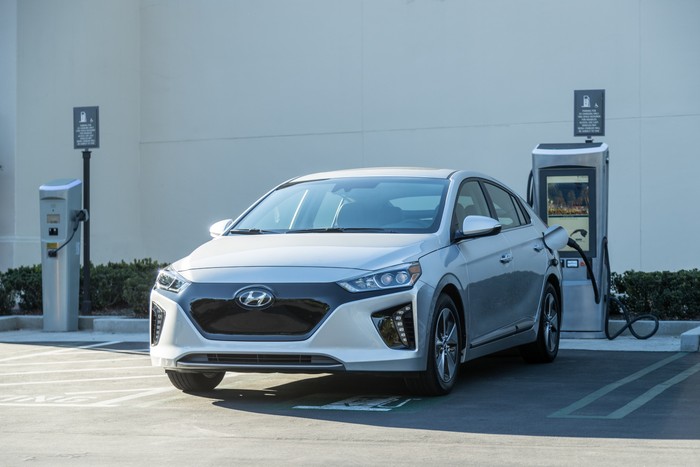

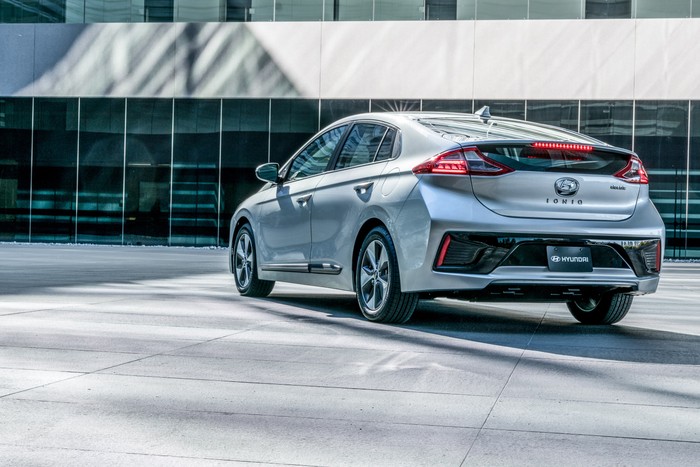
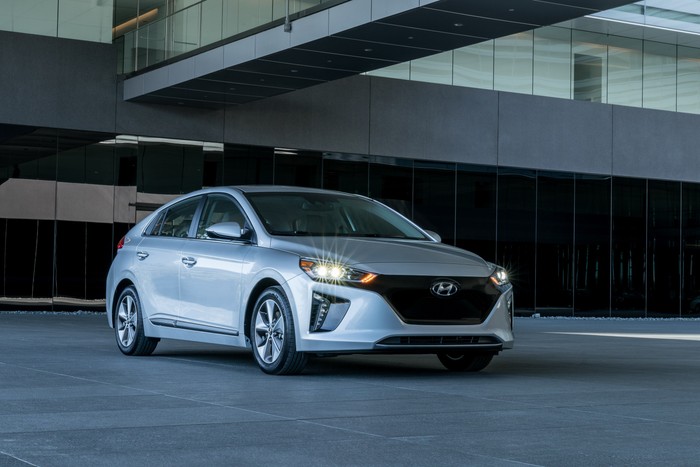
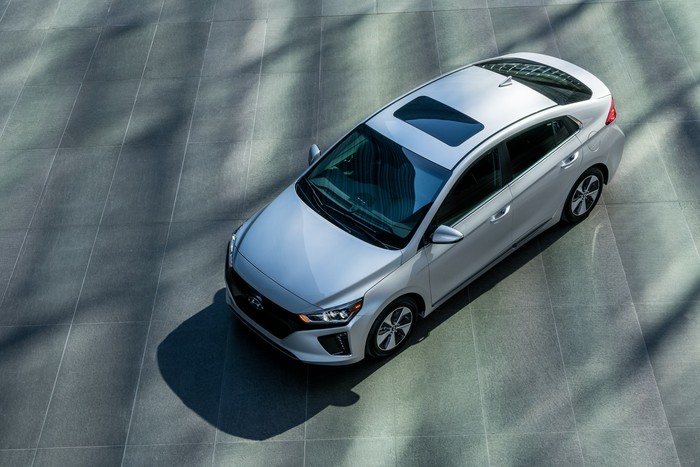
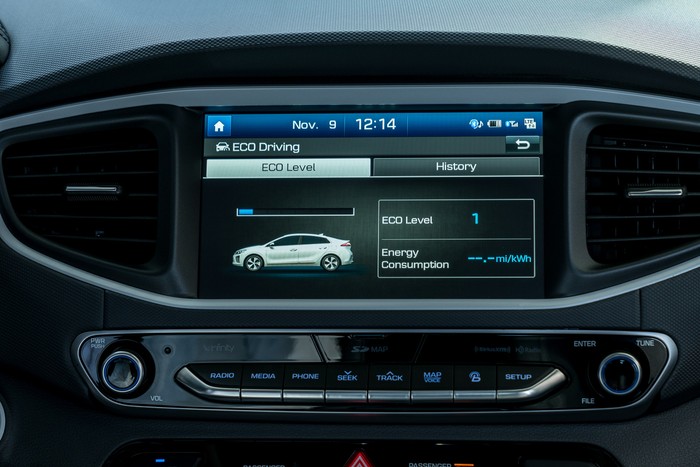

- Propulsion: Gas 1.6L I4
- Power: 104hp
@
5700rpm - Torque: 109ft⋅lb
@
4000rpm - Mileage: 58 MPG ( 57 city, 59 hwy)
- Transmission: 6-speed Automatic
- Seating: 4 seats
in
2 rows - Passenger Volume: 96.2cu ft
- Length: 176in
- Wheelbase: 106.3in
- Height: 56.9in
- Weight: 2996lbs
- Cargo Volume: 26.5cu ft
- Front Leg Room: 42.2in
- Front Head Room: 39.1in
- Front Hip Room: TBDin
- Rear Leg Room: 35.7in
- Rear Head Room: 37.4in
- Rear Hip Room: TBDin
- Drag Coefficient: TBD
- Drag Coefficient: 0.24